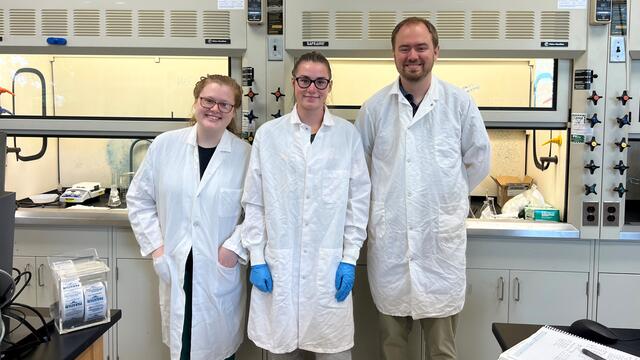In the lab: students illuminate sunscreen performance
We wear sunscreen to prevent burns, but have you ever wondered if your go-to formula is really blocking the sun? To find out, student researchers are testing the light-blocking abilities and chemical compositions of popular sunscreens as part of the Student-Faculty Collaborative Summer Research Program.

Michaela Richardson, Angalyn Strouse, professor Michael Polen (l-r), and Xochitl Arzate-Juarez are investigating the composition and efficacy of top sunscreen brands inside the lab — and out in the sun.

Strouse reviews the data she gathered from the UV sensor.
Angalyn Strouse, a junior Biology major from Spring Grove, Pennsylvania, carefully spreads sunscreen on a quartz glass slide, sets it above an ultraviolet light (UV) sensor, then sits back to wait for 10 minutes while gathering the data.
She’s outside of Lewis Hall of Science, where drifting clouds change the brightness of the sun every so often. After time is up, the UV sensor and some graphing software will have tracked just how many harmful rays passed through the sunscreen.
“I want to be a dermatologist,” Strouse says. “I love different skin care and sunscreens, and you hear about them all the time on social media. But what’s true, and what’s not?”
To investigate her passion project, she connected with Chemistry lecturer and environmental chemist Michael Polen, and fellow students Michaela Richardson of Lusby, Maryland, and Xochitl Arzate-Juarez of Baltimore, who are investigating other elements of sunscreens in the donor-funded Student-Faculty Collaborative Summer Research program.

Richardson adds sunscreen samples to test tubes to begin separating out their chemical components.
“I was ready for this,” says Richardson, a senior Health Science - Physician Assistant major. “I’ve really loved lab over the past year.” While some students bemoan the rigor and time that lab work requires, Richardson discovered she enjoys it so much that she’s now debating a lab career.
Richardson is testing sunscreens for their quantities of four standard chemicals, like octocrylene and oxybenzone. Her samples undergo extraction processes like high-performance liquid chromatography to identify their components.
The sunscreens under scrutiny are from popular brands like Banana Boat, Sun Bum, and Supergoop, and include organic-based and mineral-based ones, in powder, paste, spray, and cream consistencies with a variety of SPFs.
Senior Biology major and Forensic Science minor Arzate-Juarez is working from a biological perspective. She’s exploring how sunscreens impact the growth of spirulina, a saltwater cyanobacteria in blue-green algae that relies on photosynthesis. She’s the first researcher at McDaniel to use cyanobacteria in an experiment.
The sunscreens under scrutiny are from popular brands like Banana Boat, Sun Bum, and Supergoop, and include organic-based and mineral-based ones, in powder, paste, spray, and cream consistencies with a variety of SPFs.
Senior Biology major and Forensic Science minor Arzate-Juarez is working from a biological perspective. She’s exploring how sunscreens impact the growth of spirulina, a saltwater cyanobacteria in blue-green algae that relies on photosynthesis. She’s the first researcher at McDaniel to use cyanobacteria in an experiment.
“We know there are a lot of different sunscreens on the market. But you don’t really know if the sunscreens that are being sold actually work effectively."
“We know there are a lot of different sunscreens on the market. But you don’t really know if the sunscreens that are being sold actually work effectively,” Arzate-Juarez says.

Spirulina samples under the microscope.
According to Polen, her experiment is also relevant for considering the impact that light-blocking qualities in sunscreen may have on photosynthesizing organisms in the environment.
To test their efficacy, she uses a spectrometer to measure the light passing through a sunscreen and water solution containing the algae. She hypothesizes that sunscreens that block more UV will result in the death of the bacteria, and sunscreens that block less UV will lead to a steady or improved production of bacteria.
“This research builds the students’ skills in the lab, but also soft skills like communicating the results and working as a team. They can take this with them into their capstone projects, conferences, and graduate school."
Strouse says this research has changed her perspective on sunscreen. “The inorganic mineral sunscreens are performing better in my tests already. And after reading a lot of academic journals, the differences in sunscreen efficacy are jaw-dropping,” she says.
The Student-Faculty Collaborative Summer Research Program supports projects in all areas of the liberal arts, and provides practical and professional experiences for students beyond the classroom, with support from a faculty mentor.
“This research builds the students’ skills in the lab, but also soft skills like communicating the results and working as a team,” Polen says. “They can take this with them into their capstone projects, conferences, and graduate school. They get to talk about this cool project they did in job interviews. It’s a great way to round out their McDaniel experience.”